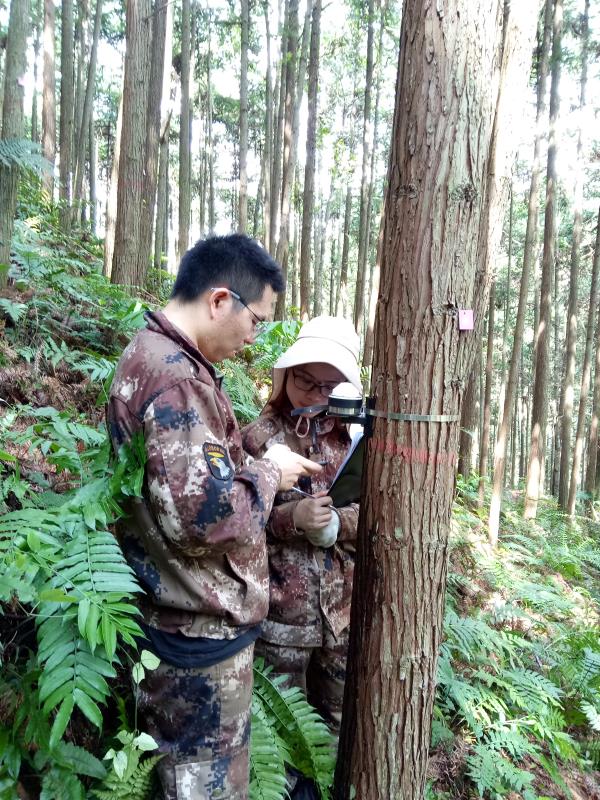 PDF(2536 KB)
PDF(2536 KB)


Radial variation of Cunninghamia lanceolata in different aged forests and its response to meteorological factors
LIU Yajing, ZHOU Lai, ZHANG Bo, CHEN Liping, PAN Lei, SUN Yujun
Journal of Nanjing Forestry University (Natural Sciences Edition) ›› 2021, Vol. 45 ›› Issue (2) : 135-144.
 PDF(2536 KB)
PDF(2536 KB)
 PDF(2536 KB)
PDF(2536 KB)
Radial variation of Cunninghamia lanceolata in different aged forests and its response to meteorological factors

【Objective】The study of tree growth mechanisms can provide an important foundation for dendrophology and reconstruction of high-resolution environmental evolution history. By analyzing the response characteristics of radial growth of trees in different ages to climate on an hourly basis,superior survival strategies can be developed for trees monitored at different ages.【Method】In the Jiangle National Forest Farm of Fujian Province, a band-dendrometer was used to monitor Cunninghamia lanceolata within forests of different ages from July 2017 to July 2018. The maximum radial growth was extracted using the maximum method, and the cumulative radial variation was simulated using the Gompertz model to analyze the annual radial variation characteristics of C. lanceolata and its response to meteorological factors.【Result】During the growing season, the daily radial changes at different ages of C. lanceolata showed similar periodicity, including systolic period, expansion recovery period and increase period. The daily radial variation of different forest ages was diverse and the daily amplitude increased with the increase in forest age. The annual growth period of C. lanceolata is relatively long, and the growth period of different ages of C. lanceolata increased gradually with the increase in forest age, but at the beginning of the growing season an opposite effect was observed. The growing seasons were as follows: early February to late October (young forest); late February to September (middle-aged forest); early March to late July (near-mature forest); and C. lanceolata did not grow in mature forests. The growth rate reached the maximum at the end of May, the beginning of May, and the end of April, respectively, in each growing season. The sensitivity of the radial growth of C. lanceolata to meteorological factors at different forest ages showed a downward trend. The growth of C. lanceolata in young forests was mainly affected by precipitation, minimum temperature, average temperature, and average relative humidity. The growth of C. lanceolata in middle-aged forests is mainly affected by precipitation and minimum relative humidity. There was no significant correlation between meteorological factors and the radial growth of C. lanceolata in near-mature and mature forests.【Conclusion】In the context of future climate change, alterations in meteorological factors may gradually affect stands in younger forests. Therefore, the management strategies used for C. lanceolata plantations in Jianle County should be adjusted to local conditions, and forest management measures should be adopted for C. lanceolata forests based on the age of the forest.

Cunninghamia lanceolate / stem radial variations / growing season / forest age / meteorological factor / Jiangle Fujian Province
| [1] |
王艺涵, 赵从举, 周雯雯, 等. 桉树树干径向生长日变化及其对环境因子的响应[J]. 天津师范大学学报(自然科学版), 2017,37(6):31-36.
|
| [2] |
|
| [3] |
|
| [4] |
|
| [5] |
江源, 杨艳刚, 董满宇, 等. 芦芽山林线白杄与华北落叶松径向生长特征比较[J]. 应用生态学报, 2009,20(6):1271-1277.
|
| [6] |
路明, 勾晓华, 张军周, 等. 祁连山东部祁连圆柏(Sabina przewalskii)径向生长动态及其对环境因子的响应[J]. 第四纪研究, 2015,35(5):1201-1208.
|
| [7] |
张建国. 森林生态学[M]. 哈尔滨: 东北林业大学出版社, 1995.
|
| [8] |
彭剑峰, 刘玉振, 王婷. 神农山白皮松不同龄组年轮-气候关系及PDSI重建[J]. 生态学报, 2014,34(13):3509-3518.
|
| [9] |
|
| [10] |
赵志江, 康东伟, 李俊清. 川西亚高山不同年龄紫果云杉径向生长对气候因子的响应[J]. 生态学报, 2016,36(1):173-179.
|
| [11] |
刘兰妹, 赵羿涵, 高露双. 杉木人工林径向生长对气候因子的响应[J]. 东北林业大学学报, 2014,42(5):6-8.
|
| [12] |
温晓示, 陈彬杭, 张树斌, 等. 不同林龄、树种落叶松人工林径向生长与气候变化的关系[J]. 植物生态学报, 2019,43(1):27-36.
|
| [13] |
韩金, 王新杰, 张鹏, 等. 不同立地条件下杉木径生长过程研究[J]. 山东农业大学学报(自然科学版), 2019(5):768-773.
|
| [14] |
|
| [15] |
李兴欢, 刘瑞鹏, 毛子军, 等. 小兴安岭红松日径向变化及其对气象因子的响应[J]. 生态学报, 2014,34(7):1635-1644.
|
| [16] |
|
| [17] |
|
| [18] |
|
| [19] |
|
| [20] |
|
| [21] |
田全彦, 肖生春, 彭小梅, 等. 胡杨(Populus euphratica)与柽柳(Tamarix ramosissima)径向生长特征对比[J]. 中国沙漠, 2015,35(6):1512-1519.
|
| [22] |
|
| [23] |
王文彬, 黑河上游青海云杉树干径向变化及液流监测研究[D]. 兰州: 兰州大学, 2017.
|
| [24] |
|
| [25] |
谭红朝, 李秧秧. 树干直径变化与其水分传输和贮存关系研究进展[J]. 西北林学院学报, 2007,22(6):51-55.
|
| [26] |
|
| [27] |
|
| [28] |
|
| [29] |
|
| [30] |
郭霞丽, 余碧云, 梁寒雪, 等. 结合微树芯方法的树木生长生理生态学研究进展[J]. 植物生态学报, 2017,41(7):795-804.
|
| [31] |
|
| [32] |
|
| [33] |
蔡礼蓉, 匡旭, 房帅, 等. 长白山阔叶红松林3个常见树种径向生长的影响因素[J]. 应用生态学报, 2017,28(5):1407-1413.
|
| [34] |
牛豪阁, 张芬, 于爱灵, 等. 祁连山东部青杄年内径向生长动态对气候的响应[J]. 生态学报, 2018,38(20):1-8.
|
| [35] |
董满宇, 江源, 杨浩春, 等. 芦芽山林线白杄生长季径向生长动态[J]. 植物生态学报, 2012,36(9):956-964.
|
| [36] |
郑勇平, 朱浩, 徐焕农, 等. 杉木生长过程特征和生长期划分[J]. 浙江林学院学报, 1991(2):219-226.
|
| [37] |
管伟, 熊伟, 王彦辉, 等. 六盘山北侧华北落叶松树干直径生长变化及其对环境因子的响应[J]. 林业科学, 2007,43(9):1-6.
|
| [38] |
于健, 刘琪璟, 周光, 等. 小兴安岭红松和鱼鳞云杉径向生长对气候变化的响应[J]. 应用生态学报, 2017,28(11):3451-3460.
|
| [39] |
|
| [40] |
|
| [41] |
|
| [42] |
郭滨德. 川西高原不同坡向和海拔云冷杉树轮对气候变化的响应差异[D]. 哈尔滨:东北林业大学, 2016.
|
| [43] |
闫伯前, 林万众, 刘琪璟, 等. 秦岭不同年龄太白红杉径向生长对气候因子的响应[J]. 北京林业大学学报, 2017,39(9):58-65.
|
| [44] |
曾令兵, 王襄平, 常锦峰, 等. 祁连山中段青海云杉高山林线交错区树轮宽度与气候变化的关系[J]. 北京林业大学学报, 2012,34(5):50-56.
|
| [45] |
闫伯前, 林万众, 刘琪璟, 等. 秦岭鳌山太白红杉径向生长对气候因子的响应[J]. 南京林业大学学报(自然科学版), 2018,42(6):61-67.
|
/
| 〈 |
|
〉 |